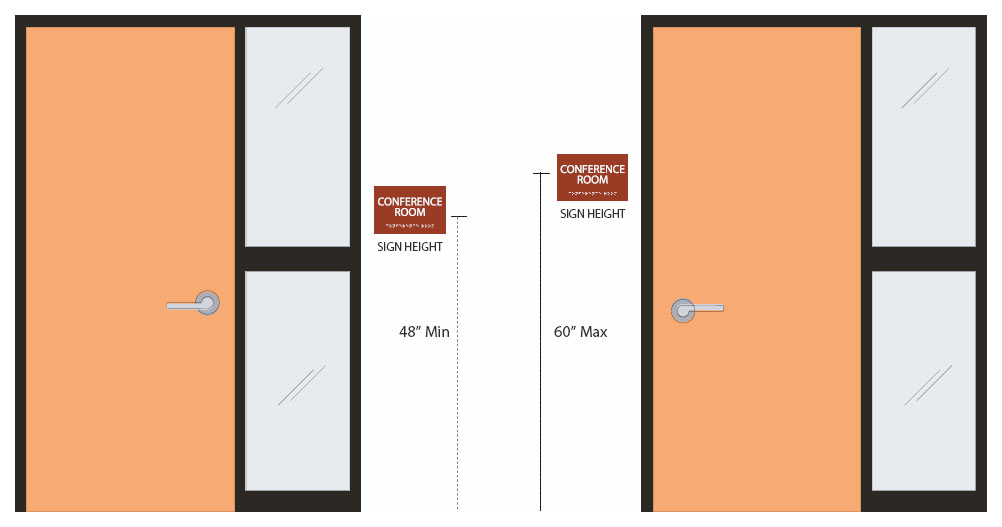The Duty of ADA Signs in Following Access Requirements
The Duty of ADA Signs in Following Access Requirements
Blog Article
Discovering the Trick Features of ADA Indicators for Boosted Availability
In the realm of availability, ADA indications serve as quiet yet powerful allies, making certain that spaces are comprehensive and navigable for people with impairments. By incorporating Braille and responsive components, these indications damage obstacles for the aesthetically damaged, while high-contrast color systems and legible typefaces cater to varied visual requirements.
Importance of ADA Conformity
Making certain conformity with the Americans with Disabilities Act (ADA) is vital for fostering inclusivity and equal accessibility in public spaces and workplaces. The ADA, established in 1990, mandates that all public centers, companies, and transportation services fit people with disabilities, ensuring they appreciate the exact same legal rights and possibilities as others. Conformity with ADA standards not only meets lawful obligations but additionally improves a company's track record by showing its dedication to variety and inclusivity.
One of the crucial elements of ADA compliance is the implementation of accessible signs. ADA indications are designed to ensure that people with handicaps can quickly navigate with buildings and spaces.
Additionally, adhering to ADA guidelines can alleviate the risk of legal consequences and possible fines. Organizations that stop working to follow ADA guidelines might face suits or penalties, which can be both monetarily difficult and harmful to their public photo. Thus, ADA compliance is integral to cultivating an equitable atmosphere for everyone.
Braille and Tactile Elements
The incorporation of Braille and responsive elements into ADA signs personifies the concepts of ease of access and inclusivity. These attributes are important for people who are blind or visually damaged, allowing them to browse public rooms with higher freedom and confidence. Braille, a tactile writing system, is crucial in providing composed information in a style that can be conveniently regarded via touch. It is normally placed beneath the equivalent message on signage to guarantee that people can access the info without visual help.
Tactile elements extend beyond Braille and include raised signs and personalities. These elements are created to be discernible by touch, enabling individuals to recognize area numbers, toilets, leaves, and various other essential locations. The ADA establishes certain guidelines relating to the size, spacing, and placement of these tactile elements to maximize readability and make sure consistency across various settings.

High-Contrast Color Pattern
High-contrast color pattern play a pivotal function in enhancing the presence and readability of ADA signs for individuals with visual problems. These systems are vital as they take full advantage of the difference in light reflectance in between text and background, making certain that indications are easily noticeable, even from a range. The Americans with Disabilities Act (ADA) mandates using specific shade contrasts to suit those with restricted vision, making it a critical element of conformity.
The effectiveness of high-contrast shades depends on their Click Here capacity to see this page attract attention in different lights conditions, consisting of poorly lit settings and locations with glare. Commonly, dark text on a light history or light message on a dark background is employed to accomplish optimum contrast. Black message on a white or yellow history gives a plain aesthetic distinction that aids in quick acknowledgment and comprehension.

Legible Fonts and Text Size
When considering the layout of ADA signs, the selection of readable font styles and appropriate message dimension can not be overemphasized. The Americans with Disabilities Act (ADA) mandates that font styles should be sans-serif and not italic, oblique, manuscript, extremely ornamental, or of unusual form.
The dimension of the message likewise plays an essential function in availability. According to ADA guidelines, the minimum message height need to be 5/8 inch, and it needs to raise proportionally with checking out distance. This is especially crucial in public rooms where signage requirements to be read promptly and precisely. Consistency in text size adds to a cohesive aesthetic experience, helping individuals in browsing atmospheres efficiently.
Moreover, spacing in between lines and letters is indispensable to clarity. Adequate spacing protects against characters from appearing crowded, boosting readability. By adhering to these criteria, designers can significantly enhance access, making sure that signs serves its designated purpose for all individuals, regardless of their aesthetic capabilities.
Efficient Positioning Strategies
Strategic placement of ADA signs is essential for taking full advantage of access and making certain compliance with lawful criteria. ADA guidelines stipulate that signs should be installed at an elevation between 48 to 60 inches from the ground to ensure they are within the line of view for both standing and seated people.
In addition, indications have to be placed surrounding to the lock side of doors to reference allow very easy identification prior to access. Uniformity in sign positioning throughout a facility improves predictability, reducing complication and enhancing total customer experience.

Verdict
ADA signs play an important function in promoting ease of access by integrating functions that deal with the demands of people with handicaps. These aspects jointly foster an inclusive environment, highlighting the relevance of ADA compliance in making certain equal gain access to for all.
In the realm of availability, ADA indications serve as silent yet effective allies, making certain that areas are inclusive and navigable for individuals with handicaps. The ADA, passed in 1990, mandates that all public facilities, companies, and transport solutions fit individuals with handicaps, ensuring they take pleasure in the exact same rights and chances as others. ADA Signs. ADA signs are made to ensure that people with handicaps can quickly navigate via areas and structures. ADA guidelines stipulate that indicators must be mounted at an elevation between 48 to 60 inches from the ground to ensure they are within the line of view for both standing and seated individuals.ADA signs play an essential function in advertising ease of access by integrating attributes that deal with the demands of individuals with handicaps
Report this page